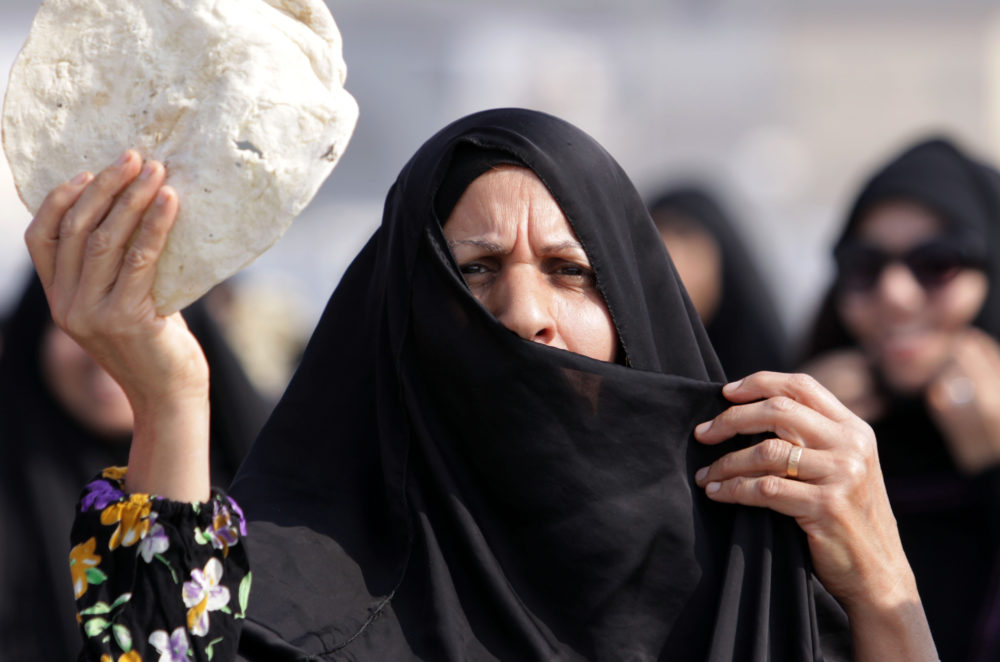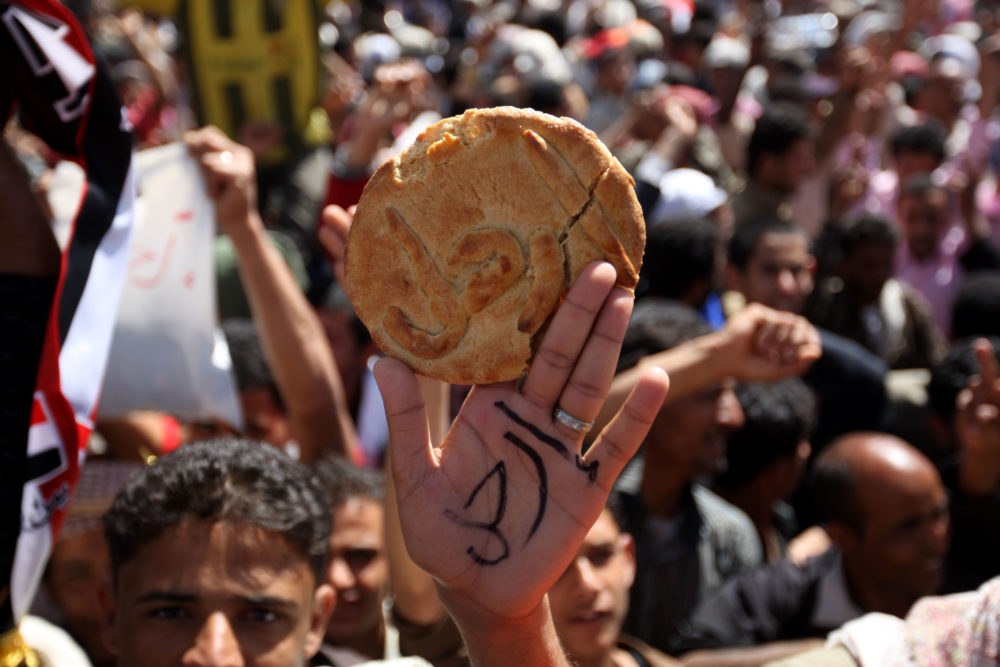Cairo, January 1977. In a spontaneous walk out from factories and universities, thousands marched to protest a commodities prices’ increase of 50 percent after an official declaration cancelled food subsidies. Demonstrations were at first peaceful. Soon they escalated, and turned to riots as police clashed with crowds. Casinos, nightclubs, and tourist bars were burned. Government shops were looted, police and fire stations attacked, foreign cars torched. The mob came dangerously close to the Presidential residence. These so-called ‘food riots’ occurred under the rule of Anwar Sadat. The president was very upset by the troubles he defined as an “uprising of thieves” and considered it an attempt to destabilize Egypt.1- See Farha Ghannam, Remaking the Modern : Space, Relocation, and the Politics of Identity in a Global Cairo (Berkeley, Calif.: Regents of the University of California, 2003). Again, thirty-four years later, in January 2011, in the context of global food prices’ hike, the Egyptian population took to the streets of downtown Cairo to oppose President Mubarak’s long-lasting regime. Marchers chanted “Bread, Freedom, Social Justice!”2- Ramy Essam, "Bread, Freedom, Social Justice!," (Cairo: Karim Ali Ismail Production, 2011). Earlier that month, in nearby Tunisia, a young fruit street-seller had set himself on fire. This desperate act sparked demonstrations that resulted in an infuriated public overthrowing the autocratic regime of Ben Ali. Demonstrators held baguettes as a symbol of protest against the rising costs of basic commodities.3- Mohamed Haddad, "Tunisia’s Baguette-Wielding Activist Gives Bread Riots Modern Meaning," The Daily Star (2011), http://www.dailystar.com.lb/News/Middle-East/2011/Jul-19/144019-tunisias-baguette-wielding-activist-gives-bread-riots-modern-meaning.ashx. During the ensuing wave of unrest that engulfed many Middle Eastern countries and affected cities across the region, bread has been an ever-present component of rallies; it has been held up above crowds, tapped on heads, and even used as a slogan board. It is a juncture of commodities and urban revolt that exposes issues pertaining to feeding cities, governance, and the spatial reality involved. More than a mere uprising of the hungry, such unrests reflect the frustration of populations suffering from obsolete development models under governments unable to provide solutions for housing, basic services, and food security, their anger symbolized by bread as a sign of both political discontent and struggle for survival.
Holding high their baguettes or baladi breads, urban rioters establish a spatial connection between issues of food supply, state policies, urbanization and poverty, in the context of political dissention. History shows that hunger and food scarcity in cities are threats to order and leadership, with urban populations more prone to uprisings than their rural counterparts.4- See Steven Kaplan, Provisioning Paris: Merchants and Millers in the Grain and Flour Trade During the 18th Century (Cornell: Cornell University Press, 1984) The dependence of the city on external sources for its food supply explains partly this. In Security, Territory, Population Michel Foucault outlines scarcity as “the present insufficiency of the amount of grain necessary for a nation’s subsistence.”5- Michel Foucault, Security, Territory, Population: Lectures at the Collège De France. 1977-1978, Eds. Michel Senellart, Francois Ewald, and Alessandro Fontana (New York: Picador, 2009), 30. He continues defining the spatial and political implications: “The immediate and most perceptible consequences of scarcity appear first of all, of course, in the urban milieu, (...) and with great probability, almost immediately leads to revolt.”6- Security, Territory, Population: Lectures at the Collège De France. 1977-1978, 30.
An urban center is a space of trade where food price increases, hoarding, and dearth are experienced first-hand, whereas in the countryside, a space of food production, shortages appear in a less abrupt way. Foucault also links riots and space with power: the fact that commodities prices rise and that food could go missing is the first step in the discrediting of a ruling regime and the questioning of its political authority. A government must feed its urban population and guarantee that urban centers are provisioned to retain power. Examples abounds in history such as the distribution of free grain (the cura annonae, "care for the grain supply") introduced in 123 BC to the people of Rome (a policy nicknamed panem et circenses, “bread and games”), or the Food Stamps programs introduced by Roosevelt in 1938 in the U.S., both instances of emblematic, politically motivated food policies, aiming to alleviate the effects of famine and to buy popularity—the solution to the practical political problem of feeding populations.7- Paul Erdkamp, "Feeding Rome, or Feeding Mars? A Long-Term Approach to C. Gracchus' Lex Frumentaria," Ancient Society 30 (2000). But by taking responsibility for welfare, governments in charge of food provisioning who fail to provide are exposed to popular discontent. This is an equation still valid today as food revolts occur in a majority in urban contexts.8- See Judy Baker, Urban Poverty : A Global View., vol. no. UP-5. , Urban Papers ; (Washington D.C. : The World Bank., 2008) and John Walton and David Seddon, Free Markets & Food Riots. The Politics of Global Adjustment (Oxford: Blackwell, 1994)
The human tendency to react against threats of survival in a collective manner is correlated to the popular mass concentrated in cities, and to its poverty level. Cities offer networks and connectivity that allow for popular organization and rapid mobilization. Demonstrations, riots, and marches of the past decade saw huge crowds materialized in the streets, pouring into and occupying public space. Urban areas offer a spatial platform for participants to gather in one place, fostering political momentum. Cities are also spaces of power and the locus of parliaments, state representatives, headquarters of international organizations; buildings that embody political regimes and economic ideologies.
In the case of Cairo, Tahrir Square, a large public space at the heart of the city, was essential to the 2011 revolution. With the classical buildings of the former American University in Cairo campus, the Umar Makram mosque, and the Egyptian Museum, along with emblematic buildings such as the headquarters of the Arab League, the Mugamma-Egypt’s bureaucracy center, Nasser’s era Nile Hilton Hotel, and Hosni Mubarak’s National Democratic Party (NDP) headquarters, the square concentrates representations of power. During the mass protests that resulted in the demise of Mubarak, demonstrators formed a safety cordon to avoid looters from plundering the treasures of the Egyptian Museum, while the NDP building was torched, a possible proof that crowds with motives have morals, sometimes. The current regime is aware of the iconic force of Tahrir Square: firstly, the NDP building—a modernist icon designed by Mahmoud Riad—empty since 2011, was simply demolished.9- René Boer, "Erasing the Remnants of a Revolution," Failed Architecture (2015), https://www.failedarchitecture.com/erasing-the-remnants-of-a-revolution/. Secondly, the government announced the creation of a new capital, to be the new home of all official buildings with the relocation of the Muggama services, the parliament, and all ministries some 50 kilometers-deep in the desert.10- "Egypt Unveils Plans to Build New Capital East of Cairo," BBC News (2015), http://www.bbc.com/news/business-31874886. Such abandonment of the city center signals the fear of ruling powers to stay in the vicinity of urban populations and of their unpredictable movements. This points to another spatial relationship between food riots and urban spaces: spatial justice.
Often, populations protesting high food prices overwhelming belong to working classes, students, and unemployed young men and women, buyers of food qualified as urban poor. Cities in less developed regions of the Southern hemisphere have been expanding rapidly as they absorb most of the population growth and rural migration.11- United Nations Department of Economic and Social Affairs, "World Urbanization Prospects- the 2011 Revision," ed. Population Division (New York2012). Overwhelmed governments faced with fast-paced urbanization have failed to keep up with the demands of growing populations and to equip new comers with updated local and national infrastructures, a situation that fosters urban poverty. A revealing case in point lays in the fact that many ‘food riots’ worldwide have started in poorer urban districts and spread to other areas of cities, with that violence typically directed at symbols of power (banks, foreign delegations, luxury stores, government buildings, etc.). In recent protests, if the link between variations in international food prices and social unrest has been openly established, urbanization has been largely left out of this equation. But because poor urban citizens spend almost 80 percent of their daily income in food, they are more exposed to sudden food price hikes than other populations.12- Eric Holt-Giménez, Raj Patel, and Annie Shattuck, Food Rebellions! Crisis and the Hunger for Justice (Oakland, CA; : Food First Books, 2009). Additionally, to palliate poor access to public infrastructure, low-income residents rely on improvised and expensive solutions for water, sewerage and transportation, additional costs that leave little budgetary buffer. Thus the inability to access affordable food combined with unemployment, governmental shortcomings, and lack of services exacerbates already harsh living conditions, a situation that consolidates social exclusion and precarious living for large portions of the urbanites in these regions.
The old man pointing his baguette like a weapon facing the police in downtown Tunis during the demise of Ben Ali, the Yemeni woman holding a flat bread in anti-regime demonstrations in Yemen, the man with his makeshift bread helmet screaming his anger on Tahrir Square on a January day of 2011 and the countless others who brought bread to protests illustrate and embody the connection between access to commodities, unrest, and spatial justice.



